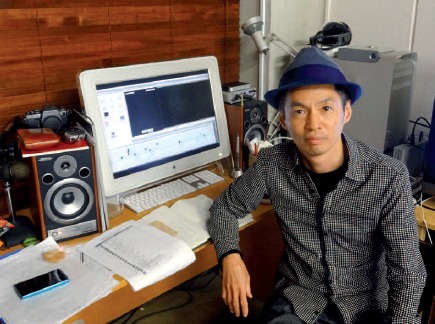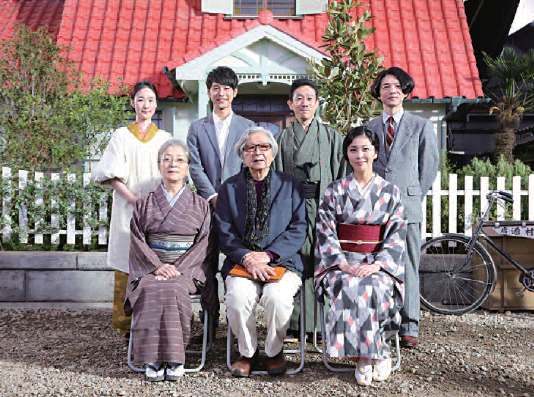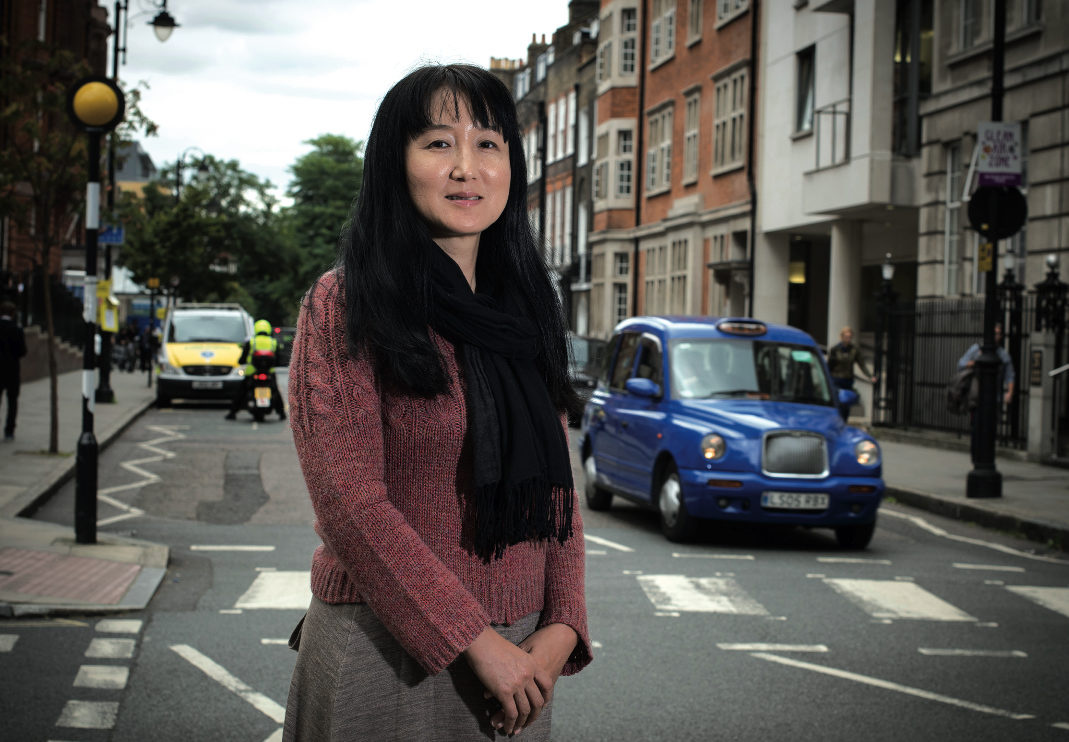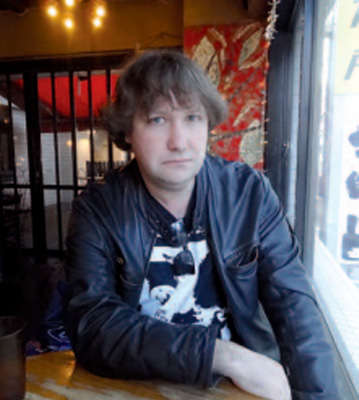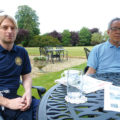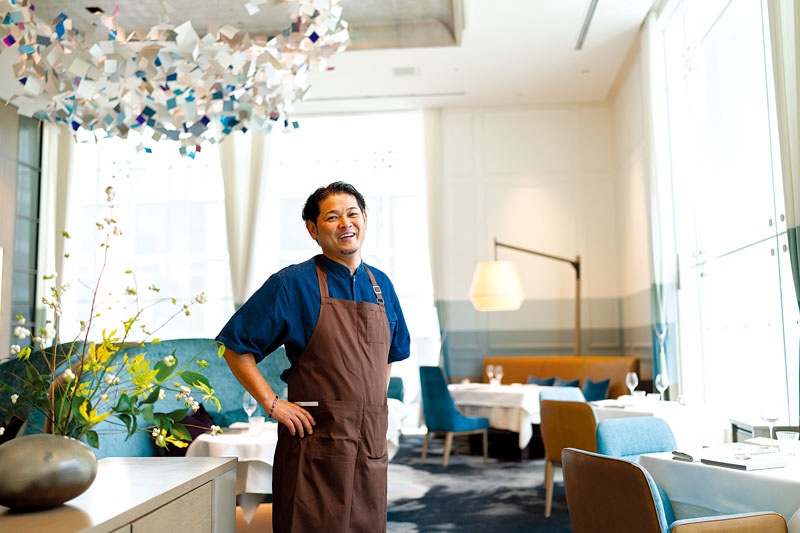
With the end of the COVID-19 pandemic, the restaurant industry, which for a long time was forced to a standstill, is up and running, and a few chefs are emerging who are taking fine cooking to a new level. A person who is attracting attention as one of the leaders of this new trend is Chef Noda Kotaro of the Italian restaurant Faro in Tokyo. Located inside the Shiseido building in Ginza, Faro was began as a luxury restaurant in 2001. However, when Noda arrived in 2018, he reinvented it as a completely different space – a place offering fine dining at relatively accessible prices while leading Italian cuisine in new directions.
Born in Imabari, Ehime Prefecture, in 1974, Noda worked part-time at an izakaya (traditional bar) during his university days, which led him to become a chef. “I didn’t have much money and had to work to pay for my studies,” he says. “Working at a restaurant was a natural choice because I could eat for free and save money. However, there was a very strict and demanding chef at the place I worked at,” he says, “and since I’m also very competitive, I wanted him to be happy with my work and take me on as his apprentice, but he flatly refused. He was the head chef at an izakaya and excelled at French cuisine. At that time, there was a huge gap between my lukewarm approach and his professionalism, and we argued every day. But even though I could not work with him, even before finishing university I made up my mind that I wanted to become a chef, so I kept looking for restaurants that interested me and after graduating, I started my career in cooking.”
Noda went on a food trip to France, England, Spain and Italy, and moved to Italy in 1999 at the age of 25. He worked in restaurants in Rome and Florence and, in 2011, he received a Michelin star while working as a chef at Enoteca la Torre in Viterbo. He then worked in Denmar and, in 2014, opened his first restaurant, Bistro 64, in Rome. In 2017, he received his second Michelin star and suddenly was on everyone’s lips. In 2018, he was offered the position of executive chef at Faro in Ginza and began a life of travelling back and forth between Italy and Japan. In 2021, Faro was awarded one Michelin star.
While Faro offers outstanding meat and seafood-based dishes, what makes it stand apart from similar restaurants is its vegan course, which is still rare in Japanese haute cuisine. Vegan menus have become established in Europe and the United States as an ethical norm that transcends food preferences, but in Japan, there are still not many top restaurants that incorporate them into their menus.
Ginza’s customer base is said to have rather conservative tastes, and Shiseido’s long-established brand strives to uphold a certain kind of traditional Japanese refinement. However, the quality of Noda’s vegan dishes eventually won over Faro’s old clientele, while attracting new fans.
One of Noda’s signature dishes is his Black Risotto coated with black olive powder. It is made with black beans from Ishikawa Prefecture, chestnut beans from Hokkaido and red kidney beans called Kita Rosso. The key to the flavour is Jugoya Miso, which is made from black koji (a kind of mould also used to make sake, shochu – a distilled spirit – soy sauce and miso). The texture is still grainy, but the inside is creamy, making it an Italian dish with a strong connection with Japanese tradition.
Another appetizer worth trying is zucchini risotto. The green zucchini-and-mint risotto uses homemade red soya bean miso as a secret ingredient. The freshly made hot risotto is topped with a frozen disk of beautiful yellow zucchini puree. In other words, it’s a zucchini sorbet, which is melted by the hot risotto underneath and eaten as a sauce.
A popular dish at Faro is potato spaghetti. It’s a vegan version of the famous pasta by Enrico Crippa, a three-star Italian chef. This ingenious dish is made by cutting potatoes into thin strips to resemble spaghetti and originally featured a sauce made with anchovies and butter. Noda, however, removed all animal ingredients and created a slightly sweet and light flavour with plant-based ingredients, spices and herbs. The crunchy texture is definitely reminiscent of pasta and, above all, the creamy sauce pairs perfectly with the potatoes. Non-vegan diners will probably wonder how Noda creates such a strong flavour even without animal products.
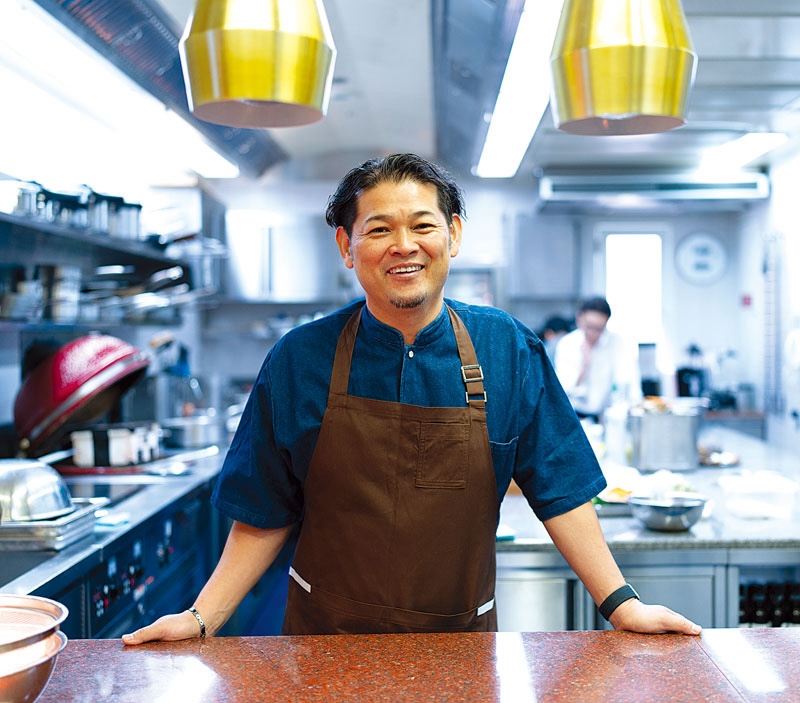
Rice and paprika mille-feuille is another dish that takes everybody by surprise. Italian carnaroli rice, generally used to make risotto, is made into chips that are piled up on top of each other to create a mille-feuille, then layered with red-and-yellow paprika sauce and green rosemary oil, and accented with smoked paprika powder. The fragrant paprika brings to mind Calabria, in southern Italy, while the crispy rice chips have a taste of northern Italy.
Noda, of course, is not alone in creating new exciting combinations. His team includes pastry chef Kato Mineko who, like Noda, has spent a long time at many famous Italian restaurants including Osteria Francescana. Her most famous cake is a petit four, a beautiful tart filled with Italian herbs and more than 20 types of edible flowers. It looks like a small herb garden blooming on the table. The original recipe requires cream made with homemade mascarpone and maple syrup, but this time they boiled rice to make the cream, and the combination of its nut base, cooked rice, soy milk cream and maple syrup is quite impressive.
“The Italian approach to cooking is very simple and easy to understand,” Noda says. “Ingredients are everything, and you choose locally produced ingredients according to each season. That same approach can be easily applied in Japan. When you think about it, Tokyo has everything. One of the great things about Tokyo is that you can use great ingredients from various parts of Japan at the right time, so more than the cooking itself, the first thing you need to do is find the right ingredients. It’s a matter of what and how you choose. Likewise, when I assembled my team of collaborators at Faro, we did a lot of homework before opening the restaurant. I asked everyone to learn about the traditions of their hometowns and the ingredients of their own regions.”
One of the issues that Noda cares about most is sustainability. “At both the high-end restaurants I had worked at and the famous gastronomy restaurants in Northern Europe I visited for training, the amount of food that was wasted in the kitchens was staggering,” he says. “It was a bit of a shock at the time. This is typical of the industry as a whole, mind you. Even now, I don’t think the situation has improved. The fact is, it doesn’t matter whether a dish is delicious or not, it’s just about impressing people, and to achieve that effect, they only use that part of the broccoli that works best – the best part – and discard the rest even though its perfectly edible.
“As I looked at the huge amount of discarded food, I decided that It wasn’t for me, I didn’t want to do that, so I went back to Rome, opened a restaurant, and started using the parts that everyone was throwing away because I thought it would be possible to use the ‘bad’ parts to serve a course at about a third of the price. The more I thought about it, the more I was convinced that another way of cooking was possible. Considering the food problems that the world is facing, I asked myself how I could convey this message through my cooking.
“I used to want to make the most delicious food and be better than anyone else. However, as I’ve been in this world for a long time, I’ve started to seriously think about what I can do to avoid wasting food. As I had a chance to work in the kitchens of award-winning restaurants, and as I learned more about what goes on behind the scenes, my passion grew increasingly stronger, and I finally decided to do something about it myself. Obviously, the primary purpose of a restaurant is to serve delicious food and give customers an unforgettable time, but if we only pursue this as a business, the earth will run out of food in the not-so-distant future. The way I do it, I can achieve the same quality, but it’s cheaper to make and more environmentally friendly. In the end, we have to change the idea of what luxury is.”
Becoming a father also played an important part in his new awareness. “I have two small children, and I think their presence in my life has given me a new perspective on my work. It’s natural for parents to want to feed their children good and tasty food. However, considering the current state of the global environment, it is perhaps even more urgent for us to realize that we cannot allow our children to live in a future where they may run out of food.”
Noda had been cooking traditional Italian cuisine for a while, but it wasn’t until he became independent and opened his own neo-bistro that he realized he had finally found his true mission, i.e. to make avoiding food waste and pursuing sustainable cooking his priority.
As soon as he opened his restaurant in Rome, Bistro 64, he received one Michelin star, earning it the unconventional accolade of being “the cheapest star in Italy”. However, it soon became apparent that making everybody happy would be a struggle. “Since around 2016, the number of American customers has increased dramatically,” he says. “This led to an increase in orders for people with allergies and requests for vegans. They didn’t mention this when confirming their booking. They just showed up and when the time came to order, they informed the waiters that they were vegan. That’s because there are so many vegetarian options in America that customers don’t have to tell the restaurant in advance.”
As he struggled to improvise vegan-friendly dishes for his customers, Noda’s eyes gradually opened to the possibilities of veganism. “In the beginning, I did what I could to satisfy those customers, but I wasn’t really passionate about it,” he says. “I almost resented having to cook that food because I wanted to do something else. Then one day an Italian apprentice of mine who was working as a chef in another restaurant invited me to his place to try a few vegan dishes. I declined his invitation because I didn’t see why I should eat something that didn’t interest me in the slightest . So he brought me one of his dishes to try, and I found it so incredibly good that my passion for vegan cuisine was born right there and then. I realized that I was the problem because I had this mental block against plant-based food.
“It takes a lot of time, effort and money to bring high-quality meat and seafood to the table for diners, and we know that this cycle will eventually cause great damage to the environment. It has already become a big problem, what with a third of human-caused methane emissions coming from livestock, mostly from beef and dairy cattle [it’s methane from their burping and manure that is one of the main causes of global warming]. It became clear to me that veganism could help solve these problems. I also realized that if the demand for vegan food increased in Italy, I might be able to carve out a niche for myself as a Japanese chef of Italian cuisine.”
In 2017, Shiseido wanted to start afresh with Faro and asked Noda to be its executive chef. “I was hesitant at first,” Noda remembers, “but I ended up accepting the job because I saw it as a chance to try new things, among them vegan cuisine. Actually, I had wanted to do plant-based food from the start, but in the beginning, it was difficult to make them understand my philosophy. So in the end, when we first opened, we decided to do both vegan and traditional cuisine, serving only a vegan menu for lunch and only meat and seafood dishes for dinner.”
Serving only a vegan lunch was a radical change from the past, and not everybody was happy. Many of Faro’s regular customers were confused by the vegan menu, and some were angry and left on hearing that they couldn’t choose meat or seafood for their main course. However, Noda didn’t give up and people began to take notice. Faro’s ratings soared and began to attract a different kind of clientele including younger foodies and curious chefs. At the same time, the number of interview requests increased dramatically from 2020.
“Before the pandemic, about 30% of our customers ordered our vegan menu and most of them came from overseas,” Noda says. “There are quite a few vegans and vegetarians among inbound tourists. They can’t find vegan food at the hotels where they’re staying and are sent here. In October 2020, in the run-up to the Olympics, the trend suddenly changed, and more Japanese people started coming to us wanting to try our vegan food, so much so we now serve 50-50. Now our customers react quite differently from how they did previously. They’re pleasantly surprised and can’t believe they’re only eating plant-based dishes. I’m sure there are people among them who don’t even know what veganism is, so Faro has become a sort of entry point to vegan cuisine. People choose this place because they hear it’s good, and in the process, they’re introduced to a new eating style. Now we seem to be popular with wealthy Indians. Many people from India are vegetarians for religious reasons and when they come to Japan they can’t find places to eat. It’s all word of mouth. I would say that in the future, we have the potential to serve exclusively vegan food at Faro.”
In 2012, world-renowned restaurant Eleven Madison Park made the switch to an entirely plant-based menu (not vegan because customers are still able to have milk and honey for coffee and tea). The three-star New York City restaurant, considered one of the best in the world, made waves in the haute cuisine world when it announced that its all-new menu would be completely meat-free. “Everybody was curious to see how customers would react,” Noda says “particularly whether they would be able to maintain their three-star status offering just a plant-based menu. When a heavyweight such as Eleven Madison Park makes such a bold move, it has the potential to become a social phenomenon. Of course, there’s also great expectation, a lot of pressure to create something of extraordinarily high quality while serving plant-based dishes.
“I guess this could only happen in America, and New York in particular, because many vegans and vegetarians live there and there’s a constant need for vegan products. I feel like it’s still a bit of a challenge for a three-star restaurant in another city to make such a change. But the time is probably right. If you look at the trends over the past 20 years, first we had Spanish cuisine, then Scandinavian food. Many were expecting South American food would be the next big thing, but it never happened. Now everyone is looking for a new exciting trend, and I think it’s vegetarian food.”
According to Noda, veganism is becoming more popular and widespread in Japan because of its culinary tradition. “After all, Japan has Buddhist shojin ryori,” he says, “so the spread of veganism is based on solid foundations. Acceptance means that vegan food will become one of many eating choices regardless of people’s lifestyles and beliefs. In other words, you don’t need to become a vegan in order to enjoy vegan food. In this respect, I am very grateful that chefs who also eat meat and fish are working on plant-based dishes. I think it’s precisely because we know how delicious meat and fish are that we strive to create vegan food that’s even more fun and delicious.”
Noda has just published Vegan Gastronomy, a bilingual book (Japanese/English) in which he has compiled recipes of his most famous dishes. The book features methods for creating 11 vegan menus and the dishes they include, as well as nine courses based on seasons and themes. Among other things, Noda introduces over 130 food items and ingredients to create including useful homemade seasonings, and how to make homemade vegan cheese as well as non-alcoholic drinks and desserts.
Gianni Simone
To learn more on the subject, check out our other articles :
N°135 [ENCOUNTER] Vegan writer Kato Hiroko
N°135 [TRAVEL] Vegan travel in Japan
Follow us !

